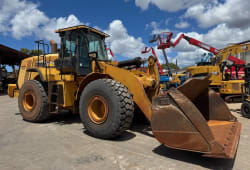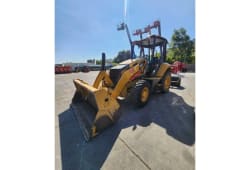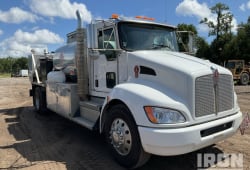Evaluating Trade-In Programs: Assessing Value for Heavy Equipment
13 Min read
)
August 11, 2023
Trade-in programs can be a valuable option for heavy equipment owners who are looking to upgrade their machinery. These programs offer the convenience of exchanging old equipment for new models, reducing the financial burden of purchasing new machinery. However, before deciding to participate in a trade-in program, it is crucial to evaluate its worth. By understanding how trade-in programs work and considering various factors, you can accurately assess the value of your heavy equipment.
Understanding Trade-In Programs for Heavy Equipment
What is a Trade-In Program?
A trade-in program is a service offered by manufacturers, dealerships, or equipment resellers that allows owners to exchange their existing equipment for a new or upgraded model. In these programs, the value of the old equipment is calculated and deducted from the cost of the new purchase.
Trade-in programs are particularly popular in the heavy equipment industry because they provide a seamless transition to newer machinery without the hassle of selling the old equipment independently.
When participating in a trade-in program, the first step is to contact the manufacturer, dealership, or equipment reseller to express your interest in the program. They will then evaluate the condition, age, and market demand for your equipment to determine its trade-in value.
Once the value is established, you can negotiate the terms and conditions of the trade-in offer. If the deal is mutually agreed upon, you can proceed with the exchange by selecting a new piece of equipment that meets your requirements. The trade-in value will be deducted from the total cost of the new purchase, resulting in a reduced out-of-pocket expense.
Benefits of Trade-In Programs
Trade-in programs offer several benefits for heavy equipment owners. Firstly, they provide a convenient and hassle-free way to upgrade to newer equipment. Instead of spending time and effort on finding a buyer for your old machinery, a trade-in program allows you to seamlessly transition to a more advanced model.
Additionally, trade-in programs often offer competitive trade-in values. Manufacturers and dealerships understand the value of customer loyalty and repeat business, so they strive to provide fair and attractive trade-in offers to encourage customers to stay within their brand or dealership.
Furthermore, participating in a trade-in program can help you save money. By deducting the trade-in value from the cost of the new purchase, you effectively reduce the out-of-pocket expense. This can be especially beneficial for businesses or individuals looking to upgrade their heavy equipment without breaking the bank.
Considerations for Trade-In Programs
While trade-in programs can be advantageous, it's important to consider a few factors before participating. Firstly, it's crucial to thoroughly research the market value of your equipment to ensure that you are receiving a fair trade-in offer. Comparing prices from multiple manufacturers, dealerships, or resellers can help you gauge the market value and negotiate a better deal.
Additionally, it's essential to carefully assess your needs and requirements for the new equipment. Take into account factors such as the specific tasks you need the equipment to perform, the expected lifespan of the new machinery, and any additional features or specifications that are important to you. By thoroughly evaluating your needs, you can make an informed decision and select the most suitable equipment for your purposes.
Lastly, it's worth considering the overall cost of ownership beyond the trade-in value. Take into account factors such as maintenance and repair costs, availability of spare parts, and the reputation of the manufacturer or dealership. Evaluating these aspects can help ensure that you are making a wise investment and selecting a reliable and cost-effective piece of heavy equipment.
Factors to Consider When Evaluating Trade-In Programs
When it comes to evaluating trade-in programs for your heavy equipment, there are several important factors to consider. These factors can greatly influence the trade-in value you receive and ultimately impact your decision-making process. Let's take a closer look at some of these factors.
Condition of the Equipment
One of the most significant factors that determine the trade-in value of your heavy equipment is its condition. Well-maintained machinery with minimal wear and tear is more likely to fetch a higher value compared to equipment that has not been properly taken care of.
Before participating in a trade-in program, it is highly advisable to thoroughly inspect your equipment and address any minor damages. Repairing these damages and ensuring that all components are in good working order not only increases the value of your trade-in but also showcases your commitment to equipment maintenance. This can leave a positive impression on potential buyers and increase your chances of getting a better trade-in offer.
Market Demand for Your Equipment
Another crucial factor to consider when evaluating trade-in programs is the current market demand for your specific type of heavy equipment. The demand for certain equipment can fluctuate over time, and this can directly impact its trade-in value.
Researching the current market trends and assessing the demand for your equipment before participating in a trade-in program is highly recommended. By doing so, you can set realistic expectations and negotiate a fair trade-in value. If your equipment is in high demand, you may receive a more competitive trade-in offer. However, if there is a surplus of similar equipment available, the trade-in value may be lower.
Age and Usage of the Equipment
The age and usage of your equipment are also crucial factors in determining its trade-in value. Generally, newer equipment with lower usage hours will yield higher trade-in values.
If your equipment is beyond its warranty period or has been extensively used, the trade-in value may be lower. However, it's important to note that if the equipment has been well-maintained and the hours of usage are within acceptable limits, it can still fetch a reasonable trade-in value. Providing a complete service history along with your equipment can also positively impact its trade-in value.
In conclusion, when evaluating trade-in programs for your heavy equipment, it is essential to consider the condition of the equipment, the market demand for your specific type of equipment, as well as the age and usage of the equipment. By carefully assessing these factors and making informed decisions, you can maximize the trade-in value of your equipment and make the most out of your trade-in program experience.
Assessing the Value of Your Heavy Equipment
When it comes to heavy equipment, accurately valuing your machinery is of utmost importance. Whether you are considering a trade-in program or simply want to know the worth of your equipment, a precise valuation ensures that you receive fair compensation. Overvaluing or undervaluing your machinery can lead to undesirable outcomes, such as overpaying for a new purchase or accepting a lower trade-in value than deserved.
So, how do you go about determining the accurate market value of your heavy equipment? Well, conducting a thorough evaluation and leveraging multiple valuation methods is key. By doing so, you can establish a solid foundation for negotiation with trade-in program providers.
Methods for Determining Equipment Value
When assessing the value of your heavy equipment, there are various methods you can utilize:
Compare recent sales: One effective way to gauge the current market value of your equipment is by researching recent sales of similar machinery. Online marketplaces, industry publications, and equipment auctions are excellent sources for this information. By analyzing the prices at which similar equipment has been sold, you can get a sense of what your machinery might be worth.
Consult experts: Seeking advice from equipment appraisers or industry professionals who have experience in valuing heavy machinery can be highly beneficial. These experts can provide valuable guidance and validation for your equipment's worth. With their insights, you can gain a deeper understanding of the factors that impact the value of your machinery.
Consider residual value: Another factor to take into account when valuing your heavy equipment is its potential residual value. Some manufacturers offer published residual value tables that estimate the future worth of their machines. Considering the projected depreciation and residual value of your equipment can help you make informed decisions regarding trade-in programs or future purchases.
By combining these approaches, you can develop a comprehensive understanding of your equipment's value. Armed with this knowledge, you can confidently negotiate with trade-in program providers, ensuring that you receive fair compensation for your heavy machinery.
Remember, accurate equipment valuation is not only crucial for trade-in programs but also for making informed decisions about buying or selling heavy equipment. By investing time and effort into determining the true value of your machinery, you can navigate the market with confidence and maximize your returns.
Pros and Cons of Trade-In Programs
Trade-in programs have become increasingly popular in recent years as a convenient and cost-effective way to upgrade your equipment. Whether you're looking to trade in your old smartphone, laptop, or even a piece of heavy machinery, these programs offer a range of benefits and potential drawbacks to consider.
Benefits of Trade-In Programs
One of the key advantages of trade-in programs is the convenience they offer. Instead of going through the hassle of selling your equipment privately, which can involve creating listings, negotiating with potential buyers, and arranging for shipping or meet-ups, trade-in programs streamline the process. With just a few clicks, you can get an estimate of your equipment's value and initiate the trade-in process.
Another benefit of trade-in programs is the opportunity to clear out your old inventory. If you have outdated equipment that is challenging to sell independently, trade-in programs provide a hassle-free solution. By trading in your old equipment, you can get rid of it while upgrading to newer models that better suit your needs.
The reduced upfront cost is another advantage of trade-in programs. When you trade in your equipment, you can offset the cost of new machinery, reducing the financial burden of purchasing outright. This can be particularly beneficial for businesses or individuals looking to upgrade their equipment on a budget.
Potential Drawbacks of Trade-In Programs
While trade-in programs offer many advantages, there are also potential drawbacks to consider. One of the main concerns is the possibility of receiving a lower value for your equipment compared to selling it independently. Trade-in offers may not always provide the highest value, as the program provider needs to factor in various costs, such as refurbishing or reselling the trade-in equipment.
Another potential drawback is the limited options that trade-in programs can present. These programs typically restrict your choices to the brands and models offered by the provider. If you have a preference for a different manufacturer or specific features, this could limit your options and make it challenging to find the perfect replacement for your old equipment.
Timing constraints are also a consideration with trade-in programs. Many programs require you to replace your equipment within a certain timeframe, often within a few months of initiating the trade-in process. If you are not ready to upgrade immediately or prefer to wait for a specific release or promotion, these timing constraints could pose a challenge.
It's essential to weigh the pros and cons of trade-in programs based on your specific needs and circumstances. While they offer convenience and cost savings, it's crucial to consider the potential trade-offs and ensure that the program aligns with your preferences and requirements.
Case Study: Successful Trade-In Programs
Trade-In Program Success Stories
Several heavy equipment owners have experienced successful trade-in programs, benefiting from their decision to participate. For example:
John, a construction company owner, decided to participate in a trade-in program to upgrade his fleet of excavators. By leveraging the program, John was able to exchange his older models for advanced machines that improved his operations' efficiency.
With his new excavators, John was able to complete projects more quickly and with less downtime. The advanced features of the upgraded machines allowed his team to work more efficiently, resulting in increased productivity and higher profitability for his business. Additionally, the improved fuel efficiency of the new excavators helped John reduce his operating costs, making the trade-in program a smart financial decision.
Lisa, a farmer, used a trade-in program to replace her tractor with a more powerful and fuel-efficient model. The trade-in value of her existing tractor significantly reduced the overall cost of the new purchase, making it a wise financial decision.
With her new tractor, Lisa experienced a significant boost in productivity on her farm. The increased power of the upgraded model allowed her to tackle more demanding tasks, such as plowing larger fields or pulling heavier loads. Additionally, the improved fuel efficiency of the new tractor helped Lisa save on fuel expenses, contributing to her overall profitability. The trade-in program not only helped Lisa upgrade her equipment but also provided her with a competitive advantage in the agricultural industry.
Lessons Learned from Successful Trade-Ins
Based on success stories like John and Lisa's, there are valuable lessons to be learned when participating in a trade-in program:
- Research trade-in programs: Thoroughly investigate different trade-in programs to find the one that aligns with your needs and offers the best value.
- Before participating in a trade-in program, it is essential to research and compare various options available in the market. Consider factors such as the reputation of the program, the trade-in value offered, and any additional benefits provided. By conducting thorough research, you can ensure that you choose a trade-in program that suits your specific requirements and provides the best value for your equipment.
- Prepare your equipment: Invest time and effort into maintaining and repairing your equipment to maximize its trade-in value.
- Before participating in a trade-in program, it is crucial to ensure that your equipment is in the best possible condition. Regular maintenance and repairs can help maximize its trade-in value. Take the time to inspect your equipment thoroughly, address any issues, and perform necessary maintenance tasks. By presenting well-maintained equipment, you increase the chances of receiving a higher trade-in value.
- Consider long-term benefits: Evaluate how the upgraded equipment will impact your operations and long-term efficiency.
- When considering a trade-in program, it is important to assess the long-term benefits that the upgraded equipment will bring to your operations. Look beyond the initial cost savings and evaluate how the new equipment will improve efficiency, productivity, and overall performance. Consider factors such as advanced features, increased power, improved fuel efficiency, and potential time-saving capabilities. By looking at the bigger picture, you can make an informed decision that aligns with your business goals and objectives.
Conclusion: Is a Trade-In Program Right for You?
Key Takeaways for Heavy Equipment Owners
Before deciding to participate in a trade-in program, consider the following key takeaways:
- Assess the condition, age, and demand for your equipment to determine its trade-in value accurately.
- Thoroughly evaluate the pros and cons of trade-in programs to determine if they align with your requirements.
- Conduct comprehensive research to find the best trade-in program that offers competitive value and meets your needs.
Final Thoughts on Trade-In Programs
Trade-in programs can provide heavy equipment owners with a convenient and cost-effective option for upgrading their machinery. However, it is essential to evaluate the value of the trade-in offer accurately and consider all aspects before committing to a trade-in program. By doing so, you can maximize the benefits of participating in a trade-in program and make an informed decision that aligns with your business goals.

Caleb Woods is an experienced content specialist and an editor at Boom & Bucket, blending his journalism background with expertise in the heavy equipment industry. He delivers engaging, informative content to help professionals stay informed and make smarter decisions in the machinery market.














